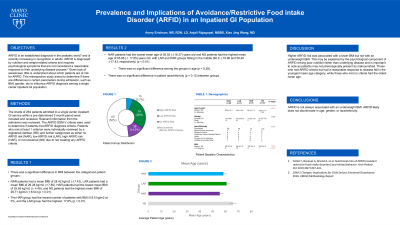Monday Poster Session
Category: Functional Bowel Disease
P1956 - Prevalence and Implications of Avoidant/Restrictive Food Intake Disorder (ARFID) in an Inpatient GI Population
Monday, October 23, 2023
10:30 AM - 4:15 PM PT
Location: Exhibit Hall

Has Audio
- AE
Avery E. Erickson, MS, RD
Mayo Clinic
Rochester, MN
Presenting Author(s)
Avery E. Erickson, MS, RD, Anjali Rajagopal, MBBS, Xiao Jing Wang, MD
Mayo Clinic, Rochester, MN
Introduction: Avoidant/Restrictive Food Intake Disorder (ARFID) is an established diagnosis in the pediatric world and is only recently increasing in recognition in adults. ARFID is diagnosed by nutrition and weight related criteria and requires psychological symptoms that are not considered a reasonable response to their underlying disease process. Given lack of awareness, ARFID is infrequently recognized in adult patients, and little is understood about which patients are at risk. This retrospective study aimed to determine if there are differences in certain parameters during admission, such as BMI, gender, etc to influence ARFID diagnosis among a single center inpatient GI population.
Methods: The charts of 264 patients admitted to a single center inpatient GI service within a pre-determined 3-month period were included and reviewed. Relevant information from the admission was reviewed. The ARFID DSM-V criteria were used to determine if patients met ARFID diagnosis criteria. Patients who met at least 1 criterion were individually reviewed by an RD and categorized as either no ARFID risk (NAR), low ARFID risk (LAR), high ARFID risk (HAR), or not screened (NS) due to not meeting ARFID criteria.
Results: There was a significant difference in BMI between the categorized patient groups. NAR patients had a mean BMI of 28.42 kg/m2 (±7.43), LAR patients had a mean BMI of 26.28 kg/m2 (±7.85), HAR patients had the lowest mean BMI of 25.65 kg/m2 (± 4.48), and NS patients had the highest mean BMI of 28.71 kg/m2 (±6.54) (p < 0.01). Interestingly, the HAR group had the lowest number of patients with BMI ≤18.5 kg/m2 at 0%, and the LAR group had the highest, 17.6% (p < 0.01). NAR patients had the lowest mean age of 55.55 (±16.37) years old and NS patients had the highest mean age of 65.96 (± 17.85) years old, with LAR and HAR groups falling in the middle (60.9 ±16.96 and 58.40 ±17.43, respectively) (p < 0.01). There was no significant difference among the groups in age (p < 0.38) or race/ethnicity (p < 0.12).
Discussion: Higher ARFID risk was associated with a lower BMI but not with an underweight BMI. This may be explained by the psychological component of ARFID driving poor nutrition rather than underlying disease and is important to note as patients may not phenotypically present as malnourished. Those who met ARFID criteria but had a reasonable response to disease fell in the youngest mean age category, while those who met no criteria had the oldest mean age.
Disclosures:
Avery E. Erickson, MS, RD, Anjali Rajagopal, MBBS, Xiao Jing Wang, MD. P1956 - Prevalence and Implications of Avoidant/Restrictive Food Intake Disorder (ARFID) in an Inpatient GI Population, ACG 2023 Annual Scientific Meeting Abstracts. Vancouver, BC, Canada: American College of Gastroenterology.
Mayo Clinic, Rochester, MN
Introduction: Avoidant/Restrictive Food Intake Disorder (ARFID) is an established diagnosis in the pediatric world and is only recently increasing in recognition in adults. ARFID is diagnosed by nutrition and weight related criteria and requires psychological symptoms that are not considered a reasonable response to their underlying disease process. Given lack of awareness, ARFID is infrequently recognized in adult patients, and little is understood about which patients are at risk. This retrospective study aimed to determine if there are differences in certain parameters during admission, such as BMI, gender, etc to influence ARFID diagnosis among a single center inpatient GI population.
Methods: The charts of 264 patients admitted to a single center inpatient GI service within a pre-determined 3-month period were included and reviewed. Relevant information from the admission was reviewed. The ARFID DSM-V criteria were used to determine if patients met ARFID diagnosis criteria. Patients who met at least 1 criterion were individually reviewed by an RD and categorized as either no ARFID risk (NAR), low ARFID risk (LAR), high ARFID risk (HAR), or not screened (NS) due to not meeting ARFID criteria.
Results: There was a significant difference in BMI between the categorized patient groups. NAR patients had a mean BMI of 28.42 kg/m2 (±7.43), LAR patients had a mean BMI of 26.28 kg/m2 (±7.85), HAR patients had the lowest mean BMI of 25.65 kg/m2 (± 4.48), and NS patients had the highest mean BMI of 28.71 kg/m2 (±6.54) (p < 0.01). Interestingly, the HAR group had the lowest number of patients with BMI ≤18.5 kg/m2 at 0%, and the LAR group had the highest, 17.6% (p < 0.01). NAR patients had the lowest mean age of 55.55 (±16.37) years old and NS patients had the highest mean age of 65.96 (± 17.85) years old, with LAR and HAR groups falling in the middle (60.9 ±16.96 and 58.40 ±17.43, respectively) (p < 0.01). There was no significant difference among the groups in age (p < 0.38) or race/ethnicity (p < 0.12).
Discussion: Higher ARFID risk was associated with a lower BMI but not with an underweight BMI. This may be explained by the psychological component of ARFID driving poor nutrition rather than underlying disease and is important to note as patients may not phenotypically present as malnourished. Those who met ARFID criteria but had a reasonable response to disease fell in the youngest mean age category, while those who met no criteria had the oldest mean age.
Disclosures:
Avery Erickson indicated no relevant financial relationships.
Anjali Rajagopal indicated no relevant financial relationships.
Xiao Jing Wang indicated no relevant financial relationships.
Avery E. Erickson, MS, RD, Anjali Rajagopal, MBBS, Xiao Jing Wang, MD. P1956 - Prevalence and Implications of Avoidant/Restrictive Food Intake Disorder (ARFID) in an Inpatient GI Population, ACG 2023 Annual Scientific Meeting Abstracts. Vancouver, BC, Canada: American College of Gastroenterology.
